Home Remedies For Anemia: 13 Effective Natural Treatments
Say goodbye to anemia with remedies that replenish deficiencies and restore strength.

Image: StyleCraze
Feeling constantly tired or weak could be a sign of anemia, a condition affecting about 1.62 billion people globally (1). It occurs when your body does not produce enough red blood cells to carry oxygen to the organs. While medications can treat it, you may also try home remedies for anemia. These natural treatments help improve your hemoglobin levels, boost energy, and support your overall health. This article lists some of the best remedies to combat anemia naturally. It also covers information on the signs, symptoms, and causes. Read on!
In This Article
13 Home Remedies To Treat Anemia
- Drumstick Leaves
- Vitamins B12 And Folate
- Blackstrap Molasses
- Green Veggies
- Vitamin C
- Probiotics
- Figs
- Beetroot
- Bananas
- Dates And Raisins
- Copper
- Black Sesame Seeds
- Iron Supplements
1. Drumstick Leaves
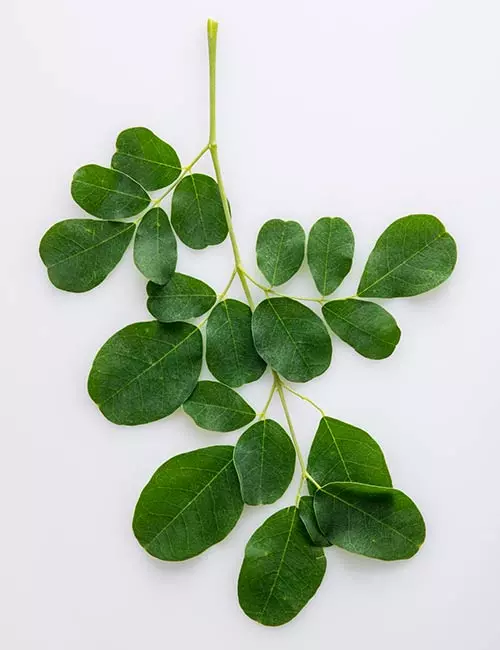
You Will Need
- 10-15 drumstick leaves
- 1 teaspoon honey
What To Do
- Chop the leaves and blend them well.
- Strain the juice.
- Add honey, stir well, and drink.
When You Need To Do This
Consume it with breakfast.
Why This Works
Drumsticks are loaded with vitamins A and C, iron, calcium, and magnesium that can help cure anemia.
Caution
If you are pregnant, take your doctor’s opinion before consuming drumsticks.
2. Vitamins B12 And Folate
You Will Need
- 2 eggs
- ½ cup baked beans
- 1 cup baby spinach
- 3-4 blanched florets of broccoli
- Salt to taste
What To Do
- Crack open the eggs on a hot non-stick pan.
- Sprinkle some salt and cook the eggs for 2-3 minutes.
- Transfer the eggs to a plate.
- Add the baked beans, blanched broccoli, and baby spinach to the plate.
When You Need To Do This
Consume it for breakfast.
Why This Works
Vitamins play a crucial role when it comes to cell function and survival. Deficiency in vitamins can cause serious diseases, including anemia. Consuming greens, eggs, and beans on a regular basis prevents vitamin B12 and folate deficiency. You can also take doctor-prescribed vitamin B12 and folate supplements.
Caution
Do not take vitamin supplements unless your doctor prescribes them. Follow the dosage.
3. Blackstrap Molasses
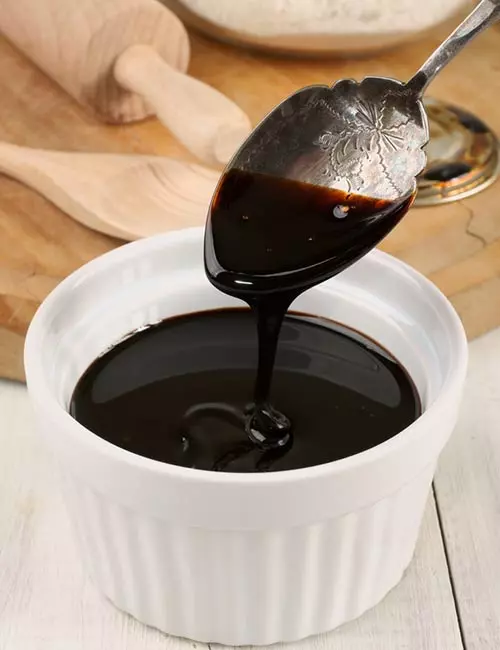
You Will Need
- 1 tablespoon organic blackstrap molasses
- 1 cup warm water or milk
What To Do
- Add a tablespoon of blackstrap molasses to a cup of warm water or milk.
- Stir well and drink.
When You Need To Do This
It is best to consume it in the morning or in the evening about 2 hours before going to bed.
Why This Works
Blackstrap molasses is a sweet by-product obtained from refining sugarcane. It is low in sugar but rich in vitamins and minerals like vitamin B6, magnesium, calcium, and selenium. Consuming blackstrap molasses can help increase the iron levels in your body, thereby improving your hemoglobin levels and RBC count (2).
Caution
Do not consume it in excess amounts as it may cause diarrhea and loose stools.
4. Green Veggies
You Will Need
- ½ cup kale
- ¼ cup chopped celery
- 1 tablespoon honey
- ½ lime
- A pinch of salt
What To Do
- Toss the chopped veggies, honey, salt, and lime juice into a blender.
- Blend well.
- Pour the smoothie into a glass and drink it.
When You Need To Do This
Consume it for breakfast or an hour before your workout.
Why This Works
Green veggies like kale, spinach, radish greens, mustard greens, arugula, broccoli, and Swiss chard are great sources of iron. Consuming these on a regular basis can help in anemia treatment.
Caution
Do not consume green juice or green veggies in excess. Have a maximum of 3-4 cups of greens per day.
Bianca Vanessa, a holistic nutritionist and youtuber, shares her experience being diagnosed with anemia and how she treated it. She discusses how changing her eating habits and becoming vegan helped restore her low iron levels. She says, “I have gone high raw vegan, eating a lot of watery fruits, having a lot of green juices and celery juice and supplementing with high quality iron supplements helped (i).”
5. Vitamin C
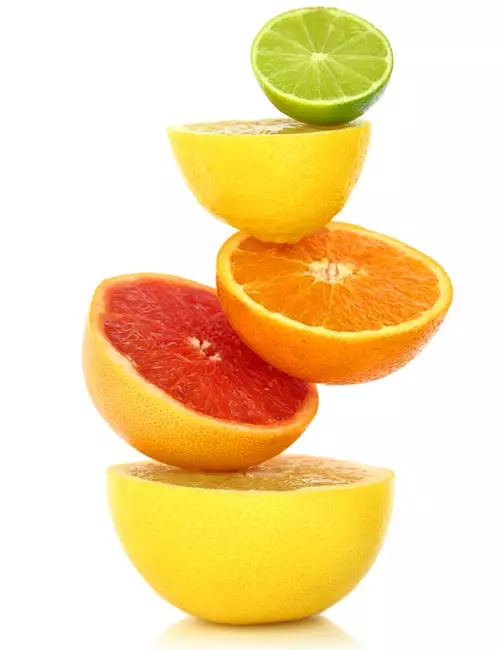
You Will Need
- ½ grapefruit
- 1 kiwi
- ½ apple
- 1 teaspoon honey
- ½ inch grated ginger
What To Do
- Scoop the grapefruit into a blender.
- Chop the kiwi with the peel and add it to the blender.
- Chop the apple and toss it in the blender.
- Add grated ginger and a teaspoon of honey to the blender.
- Blend it well.
- Pour it into a glass and drink it.
When You Need To Do This
You can have vitamin C-rich foods for morning detox, breakfast, lunch, or dinner.
Why This Works
Vitamin C is mostly found in citrus fruits. Fruits like orange, apple, lime, lemon, grapefruit, tangerine, gooseberries, apple, and berries are loaded with vitamin C and other essential vitamins and minerals that help in the production of RBCs and hemoglobin. This drink is a good source of vitamin C and will help rev up your hemoglobin levels and iron absorption.
Caution
Avoid consuming too much vitamin C in a day to prevent acidity. Also, avoid consuming it after drinking milk or any milk-based products.
6. Probiotics
You Will Need
- ½ cup yogurt
- 1 cup water
- 2 tablespoons lime juice
- A few chopped coriander leaves
- A pinch of salt
- A pinch of cumin powder
What To Do
- Blend the yogurt using a blender.
- Scoop it out into another jar.
- Add water, salt, lime juice, chopped coriander leaves, and cumin powder.
- Stir well and drink up.
When You Need To Do This
Consume it after lunch or dinner.
Why This Works
It is a well-known fact that probiotics help improve digestion and gut function. That’s because probiotic-rich foods contain good gut bacteria. Scientists have found that probiotics increase the levels of vitamin B12 and iron (3). Patients with anemia can improve their low RBC count and hemoglobin levels by consuming yogurt, a good source of probiotics. You can consume yogurt as it is or prepare buttermilk and drink it.
Caution
Avoid consuming probiotics in excess to prevent bloating and digestion issues.
7. Figs
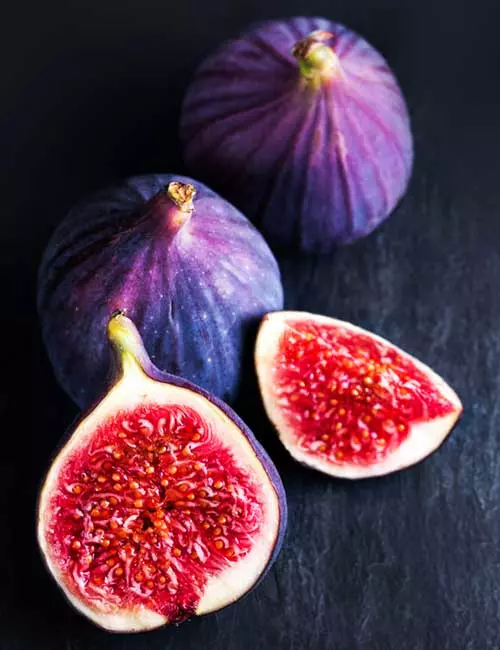
You Will Need
- 2-4 ripe figs
- 1 cup water
What To Do
- Soak the figs in a bowl of water overnight.
- Quarter the figs.
- Add them to your breakfast bowl and enjoy!
When You Need To Do This
Consume them in the morning.
How This Works
The plump and sweet figs are loaded with iron. They are also good sources of vitamin A, folate, and magnesium (4). Soaking figs helps them get digested quickly.
Caution
Overconsumption of figs can lead to digestive issues. If you are pregnant, consult your doctor before consuming figs.
8. Beetroot
You Will Need
- Beetroots
- ½ lime
- Peeler
- Juicer
- Knife
What To Do
- Wash, peel, and chop the beetroots.
- Blend them.
- Pour the mixture into a glass and squeeze in the juice of half a lime.
- Stir and drink.
When You Need To Do This
Consume it for breakfast or an hour before working out.
Why This Works
Beetroot is one of the greatest sources of iron, magnesium, calcium, vitamin A, and folate (5). A study found that giving adolescent girls beetroot juice mid-morning for 20 days showed significant improvement in hemoglobin levels (6). The lime juice not only enhances the flavor of your beetroot smoothie but also adds an extra dose of vitamin C to it.
Caution
Talk to your doctor before consuming it if you are pregnant or lactating.
9. Bananas
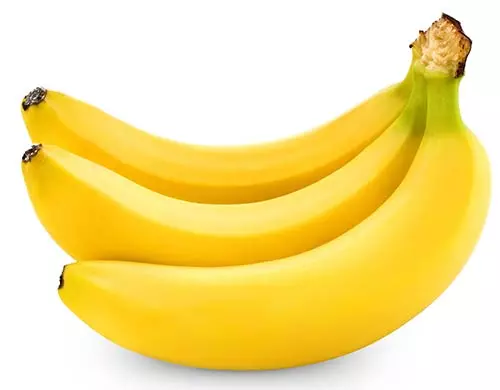
You Will Need
- 1 medium-sized ripe banana
- 1 teaspoon honey
What To Do
- Wash, peel, and slice the bananas.
- Add them to your breakfast bowl.
- Drizzle a teaspoon of honey on top. Enjoy!
When You Need To Do This
You can have bananas for breakfast.
Why This Works
You can improve your iron levels by a significant margin by consuming green or ripe bananas. Bananas are loaded with iron, potassium, vitamin C, and folate (7). They provide your body with the essential nutrients required for generating healthy RBCs and raising hemoglobin levels (8).
Caution
Since bananas are high in calories and potassium, consuming too many of them can cause weight gain and hyperkalemia.
10. Dates And Raisins
You Will Need
- 3-4 dates
- 10 raisins
What To Do
- Soak the dates and raisins in a bowl of water for 20-30 minutes.
- Strain the water and use it for consumption.
When You Need To Do This
Have raisins and dates in the morning by adding them to your breakfast bowl, smoothies, salads, or desserts.
Why This Works
Dates and raisins are good sources of iron and vitamin C. Vitamin C is an immunity booster and improves iron absorption.
Caution
Though dates and raisins are hemoglobin-rich foods, they are high in sugar and may raise your blood sugar levels.
11. Copper
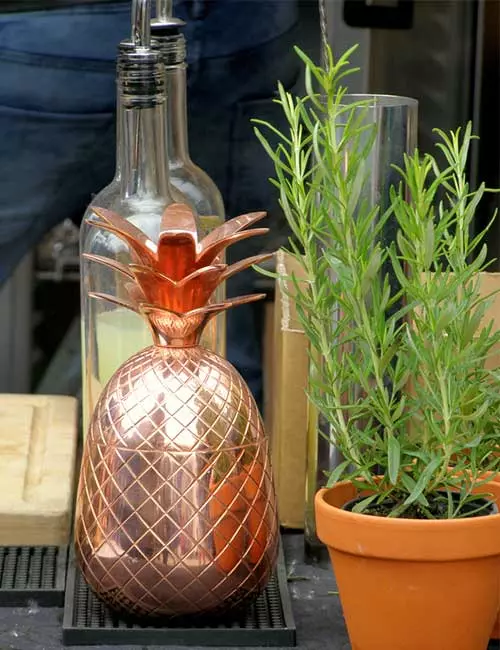
You Will Need
- A copper water bottle
- Water
What To Do
Store water in the copper water bottle and drink it as required.
When You Need To Do This
Consume copper-infused water after breakfast, lunch, or dinner.
Why This Works
Copper deficiency can also lead to anemia (9). So, you must consume enough sources of copper to keep your hemoglobin and iron levels up.
Caution
You may consume up to 10 mg copper per day. Excess copper can lead to copper toxicity resulting in fever, nausea, and diarrhea.
Tip: Consume dietary sources of copper like chicken liver, apricots, dark chocolate, lentils, chickpeas, mushrooms, sunflower seeds, quinoa, and turnip greens.
12. Black Sesame Seeds
You Will Need
- 1-2 teaspoons of black sesame seeds
- ¼ cup water
- 1 teaspoon honey
What To Do
- Soak the black sesame seeds in water for 2-3 hours.
- Strain the water and make a thick paste of the sesame seeds.
- Consume the black sesame seed paste with a teaspoon of honey.
When You Need To Do This
Consume it after breakfast every day.
Why This Works
Black sesame seeds are rich in folate, iron, calcium, and magnesium and highly essential for your diet if you are anemic. They increase your iron levels and help in the absorption of iron in your system.
Caution
Avoid this home remedy if you are allergic to sesame seeds.
13. Iron supplements
You Will Need
- Iron supplements (ferrous sulfate or ferrous gluconate)
What To Do
- Consult a healthcare provider and seek professional guidance to diagnose anemia, determine its cause, and take only the prescribed iron supplement.
- Follow the prescribed dosage and take supplements as directed, often on an empty stomach with water for better absorption.
When You Need To Do This
If you observe symptoms of anemia, such as fatigue, weakness, and pale skin, are worsening, your healthcare professional will prescribe iron supplements for anemia. These will help manage these symptoms effectively.
Why This Works
Taking iron supplements is crucial for hemoglobin and red blood cell production. Increased iron levels improve oxygen transport, relieving anemia symptoms (10).
Caution
Iron supplements may aggravate constipation or nausea (11). Hence, consult your healthcare professional before taking them.
 Quick Tip
Quick TipThese are the 13 home remedies that you can try out to improve your red blood cell count. While these remedies may help in managing anemia, they are not a magic fix and may take time to work. Also, they may not be suitable for everyone. So, it is important to talk to a healthcare provider for effective treatment. They will help you determine the underlying cause of anemia and provide personalized advice.
After reading about how to fix anemia, we shall move on to the next section to understand what types of foods you should consider to improve your condition.
What Is Anemia?
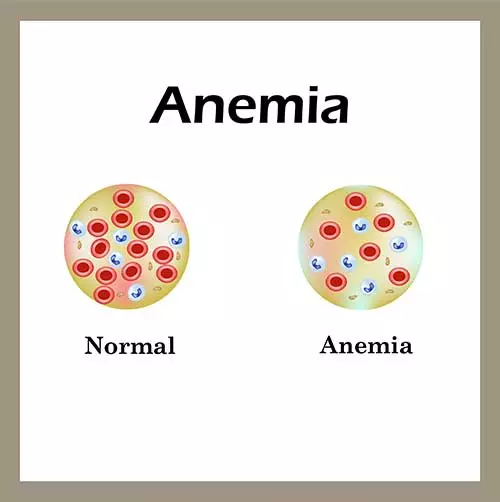
Anemia (or anaemia) is a condition in which the RBC count or hemoglobin levels drop below normal.
RBCs help transport oxygen to all parts of your body (12). Hemoglobin, an iron-rich protein present in RBCs, imparts the red color to the blood cells. It also helps bind oxygen, fight infections, and prevent blood loss by inducing blood clotting. Anemia results in less oxygen reaching various parts of your body. As a result, you develop the following symptoms.
Signs And Symptoms Of Anemia
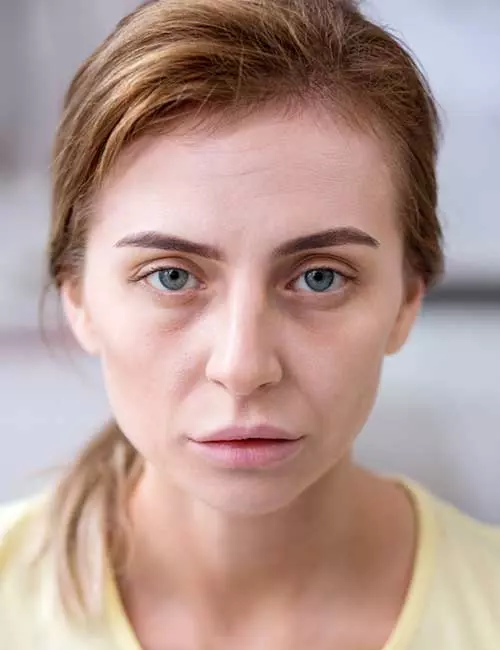
- Fatigue
- Weakness
- Pale skin
- Shortness of breath
- Cold hands and feet
- Headache
- Dizziness
- Brain fogi A general term for a group of symptoms that may impair your cognition, resulting in uncertainty, forgetfulness, and loss of focus.
- Chest pain
- Hair loss
- Irregular heartbeat
- Low stamina
- Difficulty concentrating
Let’s take a look at the causes of anemia.
Causes Of Anemia
A dip in RBC count or hemoglobin can occur due to three main reasons:
- Your body is not producing enough RBCs.
- RBCs are getting destroyed by your body.
- Blood loss due to menstruation, injury, or other causes of bleeding.
Depending on the cause, anemia can be classified into the following types:
Types Of Anemia
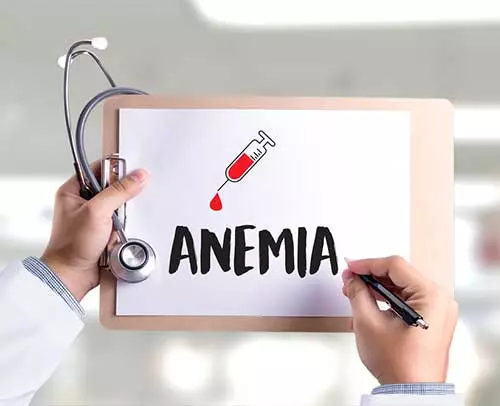
- Iron Deficiency Anemia
Iron deficiency anemia is the most common type of anemia. Iron is essential for human beings to produce hemoglobin. Blood loss, poor diet, and your body’s inability to absorb iron from food can lead to iron deficiency (13). As a result, your body fails to produce enough hemoglobin, which leads to anemia.
- Aplastic Anemia
This type of anemia is caused when your body doesn’t produce enough red blood cells (RBCs). RBCs are produced in the bone marrow every 120 days (14). When your bone marrow fails to produce RBCs, the blood count falls and leads to anemia.
- Sickle Cell Anemia
Sickle cell disease, a serious blood disorder, causes sickle cell anemia. The red blood cells are flat disc-shaped or sickle-shaped in this type of anemia. The RBCs contain abnormal hemoglobin, known as the sickle cell hemoglobin, which imparts the abnormal shape to them. Sickle cells are sticky and can block blood flow (15).
- Hemolytic Anemia
This type of anemia is caused when the red blood cells are destroyed before their normal lifespan is over. The bone marrow is unable to produce new RBCs fast enough to meet the body’s demand (16).
- Vitamin B12 Deficiency Anemia
Like iron, vitamin B12 is also needed for the proper and adequate production of hemoglobin. Most animal products are rich in vitamin B12. But if you are vegetarian or vegan, you may have vitamin B12 deficiency. This can inhibit hemoglobin production in your body, resulting in anemia. This type of anemia is also known as pernicious anemia (17).
- Thalassemia
Thalassemia is an inherited genetic disorder in which the body doesn’t create enough red blood cells. As a result, people with thalassemia can have mild to severe anemia (18).
- Fanconi Anemia
Fanconi anemia is a rare genetic blood disorder that leads to bone marrow dysfunction. Fanconi anemia prevents the bone marrow from producing enough RBCs. It can also cause the bone marrow to produce abnormal RBCs. This can result in cancer and affect the organs and tissues of your body. Children who inherit Fanconi anemia have birth defects (19).
- Blood Loss Anemia
Excessive bleeding during menstruation or bleeding caused by injury, surgery, cancer, or urinary tract or digestive tract dysfunction can lead to blood loss anemia (20).
 Fun Fact
Fun FactSo, what can happen to you when diagnosed with any of these types of anemia? Here are the risk factors you must know.
Risk Factors Of Anemia
- Women and children are more prone to developing anemia than men.
- Anemia in pregnancy is common but should not be left untreated.
- Candida infection can prevent your body from absorbing B vitamins, and vitamin B12 deficiency can lead to anemia.
- Digestive issues like Crohn's diseasei A long-term inflammatory bowel disorder that damages, inflames, and swells the lining of the digestive tract. , ulcers, and IBSi A cluster of diseases that cause gastrointestinal discomfort and swelling due to persistent inflammation. can cause anemia.
- Taking pain medications frequently can also be a risk factor for anemia.
- People over 65 years of age can develop anemia.
Looking at the signs, symptoms, and risk factors of anemia, you may jump to the conclusion that you have anemia. That may not be true. Here’s how you can find out if you have anemia.
Diagnosis
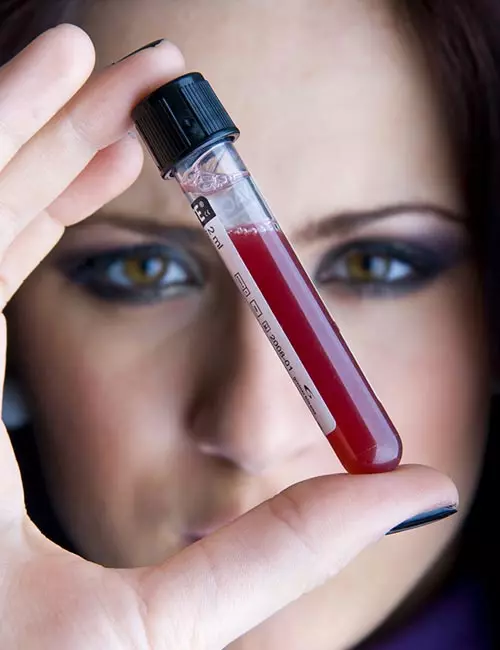
Here are the steps that your doctor will take to confirm if you have anemia.
- Family History
Since a few types of anemia are genetic, your doctor may want to know if anyone in your family has anemia.
- Physical Exam
- Listen to your heartbeat to know if there is any irregularity.
- Listen to your lungs to check if your breathing is uneven.
- Feel your abdomen to check the size of your spleen or liver.
- Complete Blood Count
Complete blood count test checks your hemoglobin and hematocrit levels. It also checks RBCs, WBCs, platelet count, and Mean Corpuscular Volumei An examination performed in a lab that assesses the typical shape and volume of a red blood cell in a blood sample. (MCV).
- Other Tests
Your doctor may ask you to get a reticulocyte test (number of young RBCs) done. They could also ask you to undergo a test to know the type of hemoglobin in your RBCs and check the iron levels in your body.
According to a 2019 report by WHO, globally around 29% of women of age 15-49 years were estimated to be anemic. The percentage of pregnant anemic women was more (around 36.5%) than those of non-pregnant women (around 29.6%). Due to these alarmingly high numbers, it is important to improve your blood count to ensure ideal health.
What Are The Best Iron-Rich Foods For Anemia?
The best iron-rich foods for anemia are:
- Banana: It is rich in iron, potassium, dietary fiber, and other vitamins and minerals, which make it the perfect food for preventing and treating anemia.
- Beetroot: Beetroot is one of the healthiest and richest plant sources of iron. Consuming it regularly can help treat and prevent iron deficiency.
- Sweet Potato: Sweet and good for weight loss, sweet potatoes are also a good source of iron. You can consume about one sweet potato per day.
- Spinach: Spinach is loaded with good carbs, vitamins, and minerals. Consuming spinach on a regular basis can help treat anemia.
- Legumes: Beans, lentils, and peas are also great gluten-free sources of iron and you must add them to your diet to improve hemoglobin levels and RBC count.
- Protein-Rich Foods: Red meat, fish, eggs, and tofu are also loaded with vitamin B12, folate, and iron that are known for treating anemia.
You may not like some of the foods we listed above. But consume them anyway if you want to reap the benefits of iron, which include treating anemia and restoring your health. Iron also improves appetite, enhances immunity, and provides energy. You can also follow the prevention and treatment tips listed below to keep anemia at bay.
Anemia Prevention And Treatment Tips
Say No To Beverages
- Red Wine
Sorry to break the news to you, but red wine is a complete no-no for now. It prevents iron absorption and interferes with your medicines and dietary approach to treat anemia.
- Black And Green Tea
Despite being good for weight loss and good health, both black and green teas prevent iron absorption. So, avoid these teas.
- Coffee
If you are not a coffee addict, good for you! But if you are, I totally understand the pain of seeing your favorite beverage mentioned on this list. Coffee inhibits iron absorption. But the good news is, you can have it after 2 hours of having an iron-rich meal. Avoid drinking it an hour before or after having a meal.
Exercise
Yoga And Exercises
Doing yoga and exercises on alternate days can help improve blood circulation and prevent you from feeling fatigued and weak all the time. However, exercise when your condition has improved a bit and you feel stronger.
Other Tips
- Take A Cold Bath
Step into a cold bath! A refreshing bath in cold water can help treat anemia. Shocked? Studies suggest that a cold water bath helps the body reach the ideal temperature needed for the proper flow of blood to all parts of the body.
- Say No To Non-Fermented Soy
While fermented soy products like sauces can aid iron absorption, non-fermented ones prevent it. So, avoid non-fermented soy products until your RBC count and hemoglobin levels are back to normal.
Infographic: Top 5 Effective Foods To Treat Anemia
Improving hemoglobin levels in the blood is necessary to treat anemia. Though there are medicines available, making dietary changes and including vitamin- and iron-rich foods in your diet are advisable. So, here is a list of the top 5 effective foods you can add to your diet to treat anemia. Check out the infographic below.
Some thing wrong with infographic shortcode. please verify shortcode syntax
You can easily manage anemia at home by enriching your diet with foods that help boost your hemoglobin levels. Foods such as drumstick leaves, blackstrap molasses, raisins, and figs are rich in iron and other nutrients and are excellent in managing anemia. However, remember that it is also important to ensure your diet is balanced and does not lack other essential nutrients such as vitamins B12, C, and other minerals. You can take supplements after consulting your doctor. Remember that remedies work best when combined with medical guidance. So, if you have an iron deficiency and suspect you may be anemic, it is best to consult your healthcare provider for a proper diagnosis.
Frequently Asked Questions
Can you die from anemia?
If left untreated, anemia can become fatal. Like all other nutrient deficiencies, you must not ignore this either. Talk to your doctor, take supplements, and follow an iron-rich diet to improve your condition.
How long does anemia last?
Once you start consuming iron-rich foods and taking supplements, you will see an improvement soon. So, it really depends on the precautions and measures you take to prevent it.
What foods to avoid if you are anemic?
Avoid tea, coffee, dairy products, and foods with oxalic acid like peanuts or parsley as they may hinder iron absorption.
Does lack of sleep cause anemia?
No, lack of sleep doesn’t cause anemia. However, anemia has been linked to lower sleep quality and insomnia.
What level of anemia is severe?
Severe anemia corresponds to blood iron levels less than 6.5 g/dl.
Can anemia turn into leukemia?
No, anemia cannot turn into leukemia. But individuals dealing with leukemia are at an increased risk of developing anemia.
Key Takeaways
- A lack of red blood cell production leads to low levels of hemoglobin that can cause anemia.
- Anemia can also be caused due to an iron deficiency, hemoglobin abnormalities, genetic factors, or excessive blood loss.
- Include iron-rich foods like drumstick leaves, green vegetables, eggs, beans, citric fruits, probiotic yogurt, fig, beetroot, and bananas.
- Foods rich in vitamin C improve immunity and iron absorption.
- Avoid drinks like wine, tea, and coffee that inhibit iron absorption.
Anemia can often go undetected. Watch the video below to learn how to identify the symptoms of anemia and 4 easy tips to treat an iron deficiency.
Illustration: Home Remedies To Cure Anemia - Symptoms, Causes, And Diet Tips
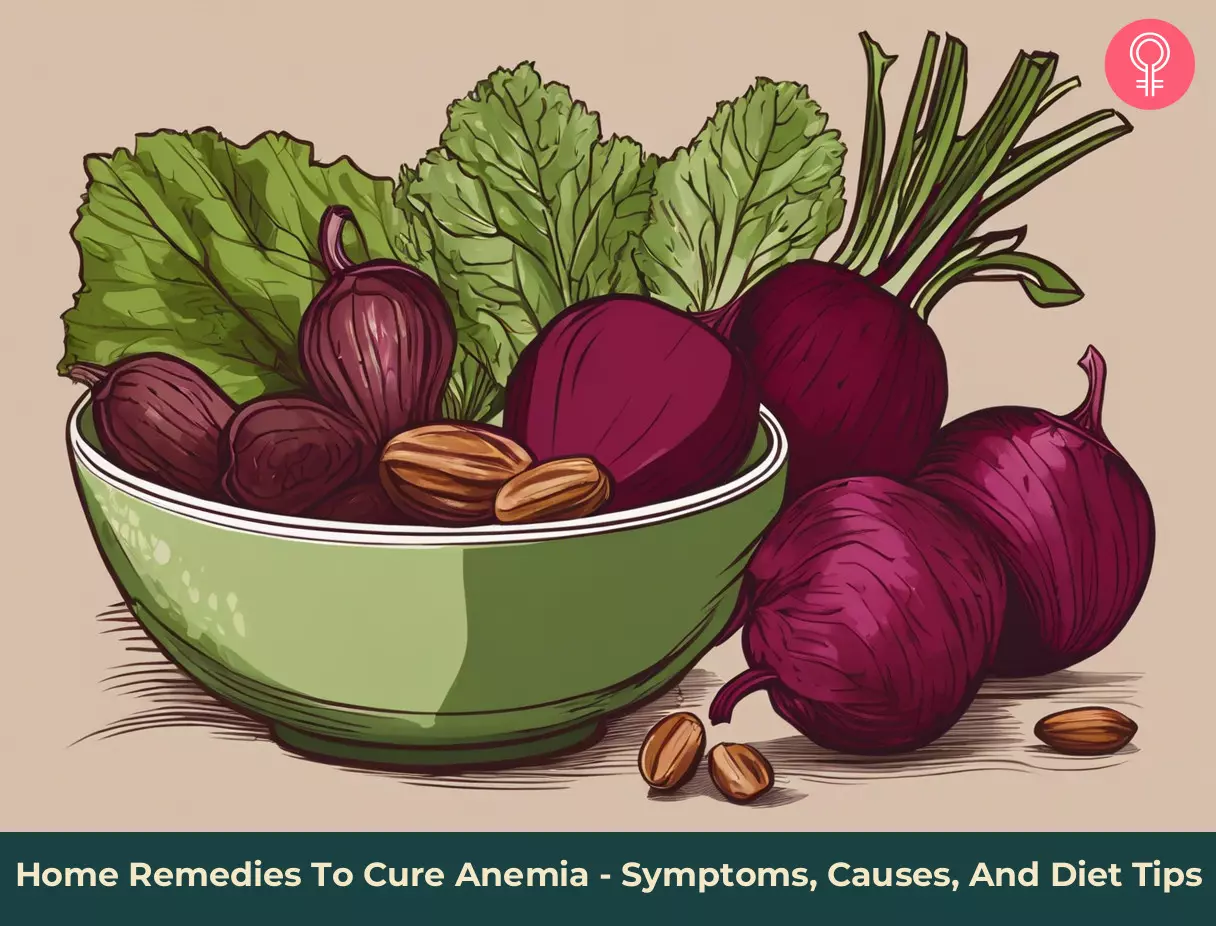
Image: Stable Diffusion/StyleCraze Design Team
Personal Experience: Source
StyleCraze's articles are interwoven with authentic personal narratives that provide depth and resonance to our content. Below are the sources of the personal accounts referenced in this article.
i. How I healed my anemia as a VEGAN | High Raw Veganism, Supplementation to prevent anemiahttps://www.youtube.com/watch?v=7QLKqwzTicc
References
Articles on StyleCraze are backed by verified information from peer-reviewed and academic research papers, reputed organizations, research institutions, and medical associations to ensure accuracy and relevance. Read our editorial policy to learn more.
- The prevalence of anemia in working women
https://www.ncbi.nlm.nih.gov/pmc/articles/PMC10518160/ - Sugarcane molasses – a potential dietary supplement in the management of iron deficiency anemia
https://pubmed.ncbi.nlm.nih.gov/28125303/ - Probiotics improve outcomes after Roux-en-Y gastric bypass surgery: a prospective randomized trial
https://pubmed.ncbi.nlm.nih.gov/19381735/ - Figs raw
https://fdc.nal.usda.gov/fdc-app.html#/food-details/173021/nutrients - Beets raw
https://fdc.nal.usda.gov/fdc-app.html#/food-details/169145/nutrients - Beet root juice on haemoglobin among adolescent girls
https://iosrjournals.org/iosr-jnhs/papers/vol2-issue1/C0210913.pdf - Bananas raw
https://fdc.nal.usda.gov/fdc-app.html#/food-details/173944/nutrients - The differences in hemoglobin levels before and after consuming ambon bananas in students
https://www.researchgate.net/publication/343176315_The_differences_in_hemoglobin_levels_before_and_after_consuming_ambon_bananas_in_students - Copper deficiency a new triad: anemia leucopenia and myeloneuropathy
https://www.ncbi.nlm.nih.gov/pmc/articles/PMC5637704/ - Review on iron and its importance for human health
https://www.ncbi.nlm.nih.gov/pmc/articles/PMC3999603/ - Ferrous sulfate supplementation causes significant gastrointestinal side-effects in adults: a systematic review and meta-analysis
https://www.ncbi.nlm.nih.gov/pmc/articles/PMC4336293/# - Blood and the cells it contains
https://www.ncbi.nlm.nih.gov/books/NBK2263/ - Iron deficiency anemia
https://www.ncbi.nlm.nih.gov/books/NBK448065/ - Aplastic anemia
https://www.ncbi.nlm.nih.gov/books/NBK534212/ - Sickle cell anemia
https://www.ncbi.nlm.nih.gov/books/NBK482164/ - Hemolytic anemia
https://www.ncbi.nlm.nih.gov/books/NBK558904/ - Pernicious anemia
https://www.ncbi.nlm.nih.gov/books/NBK540989/ - Thalassemia
https://www.ncbi.nlm.nih.gov/books/NBK545151/ - Fanconi anemia
https://www.ncbi.nlm.nih.gov/books/NBK559133/ - Acute anemia
https://www.ncbi.nlm.nih.gov/books/NBK537232/
Read full bio of Dr. Saba
Read full bio of Shaheen Naser
Read full bio of Ravi Teja Tadimalla
Read full bio of Dipti Sharma







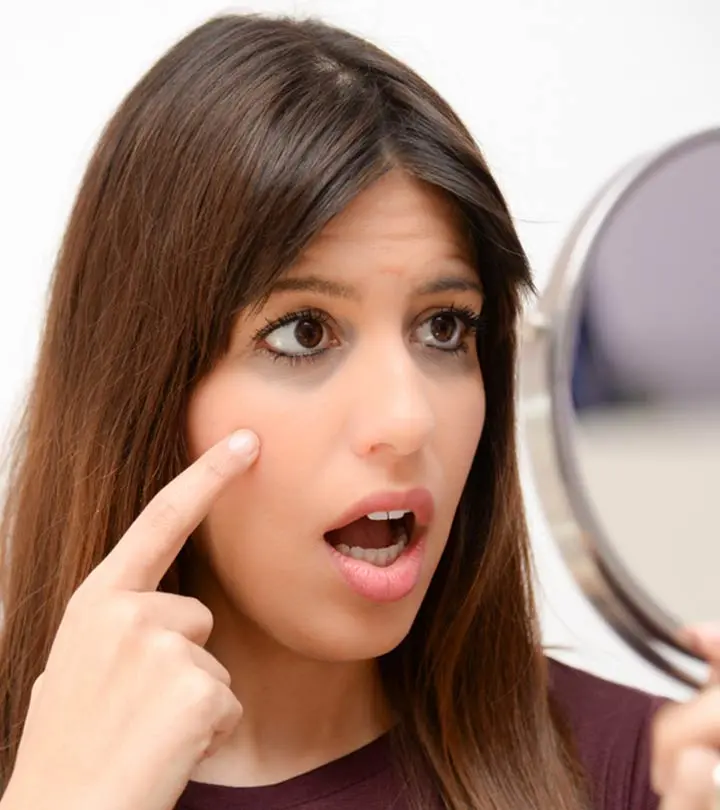

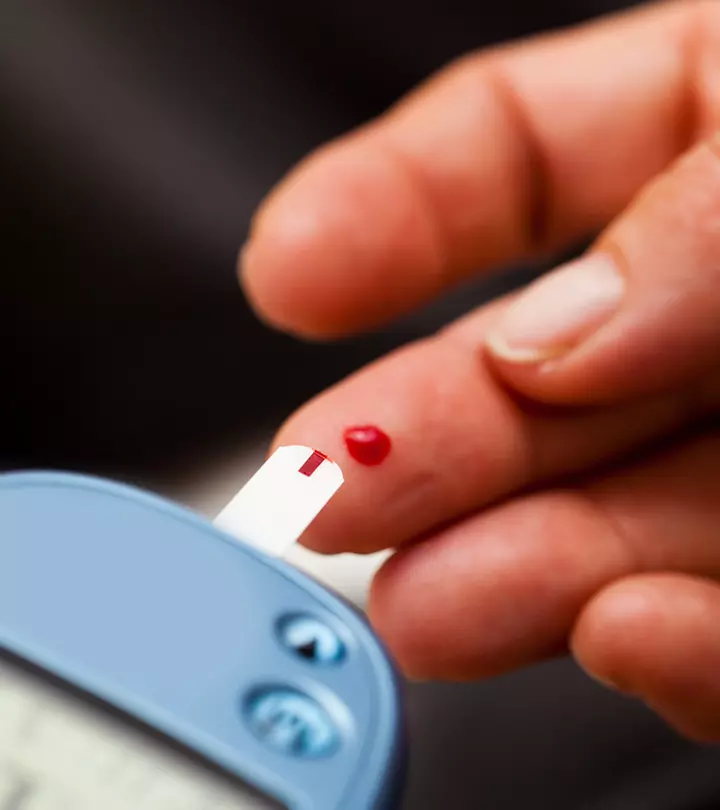
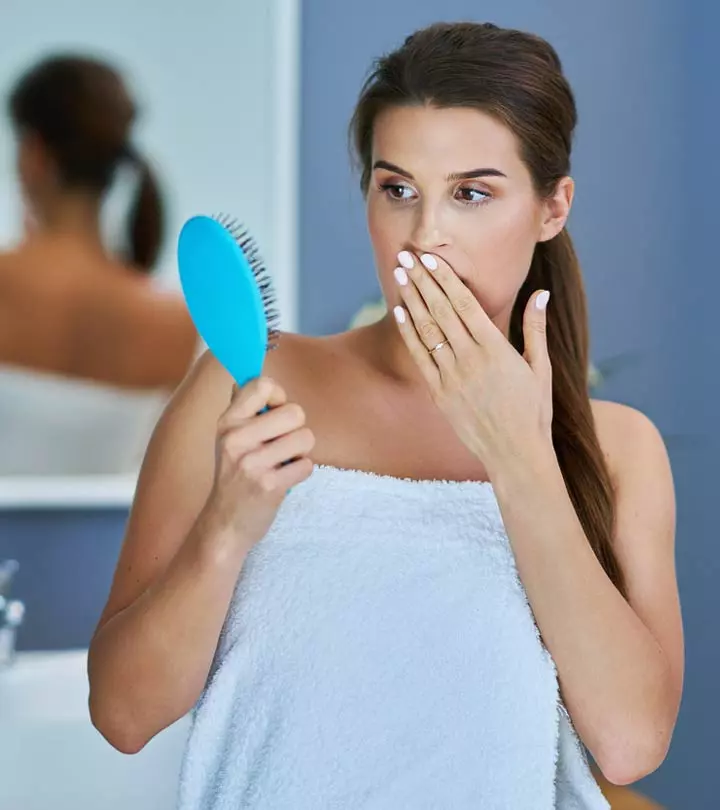

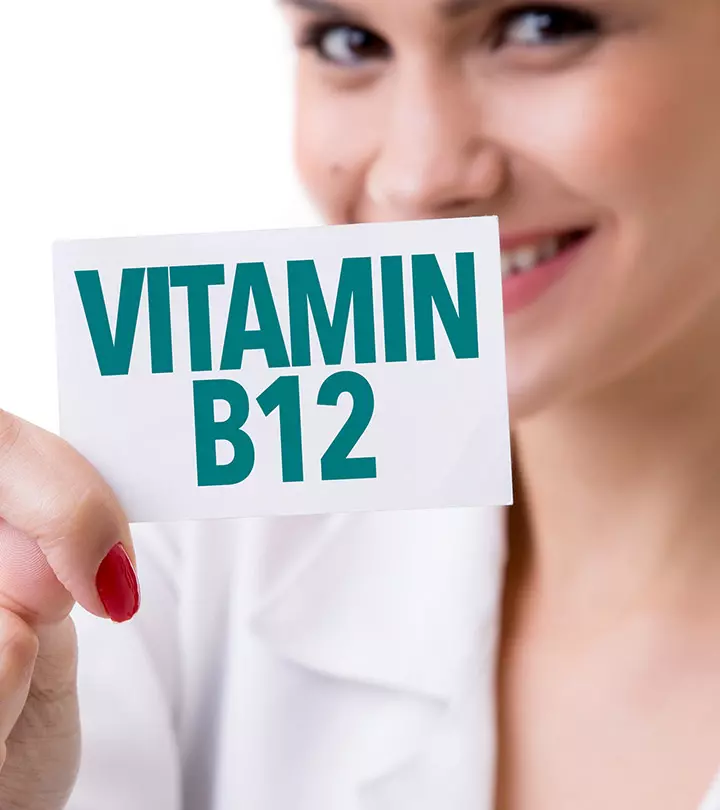
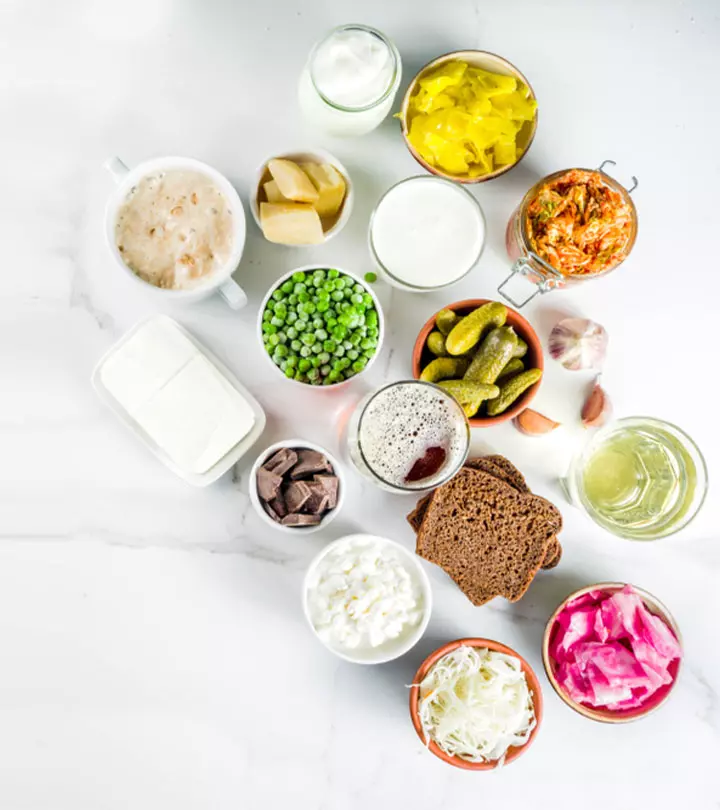

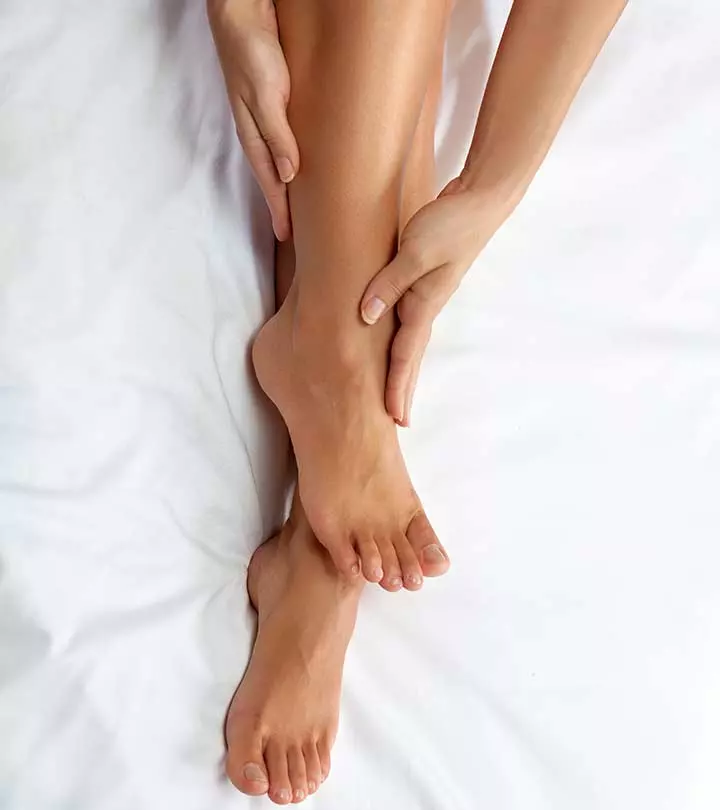


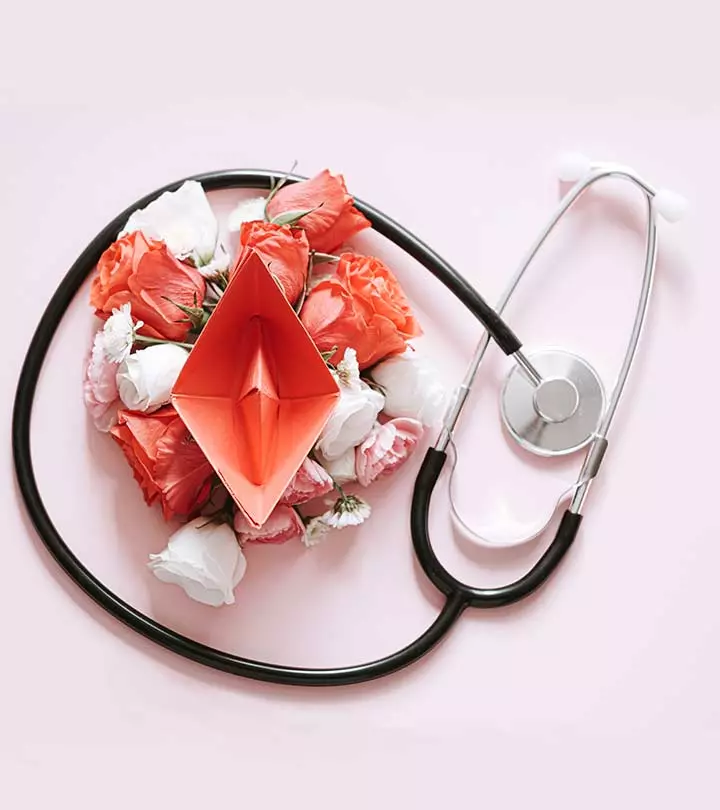
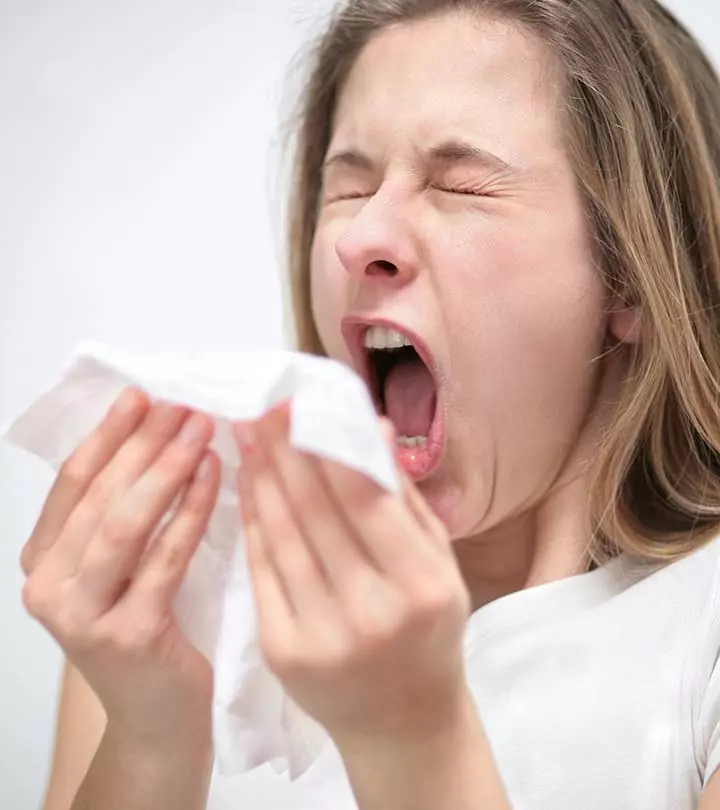

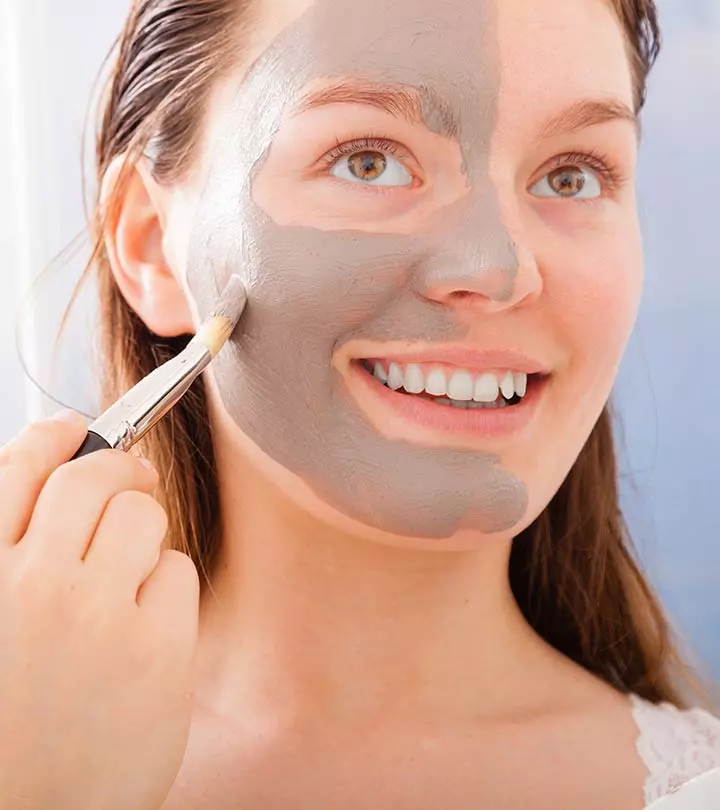
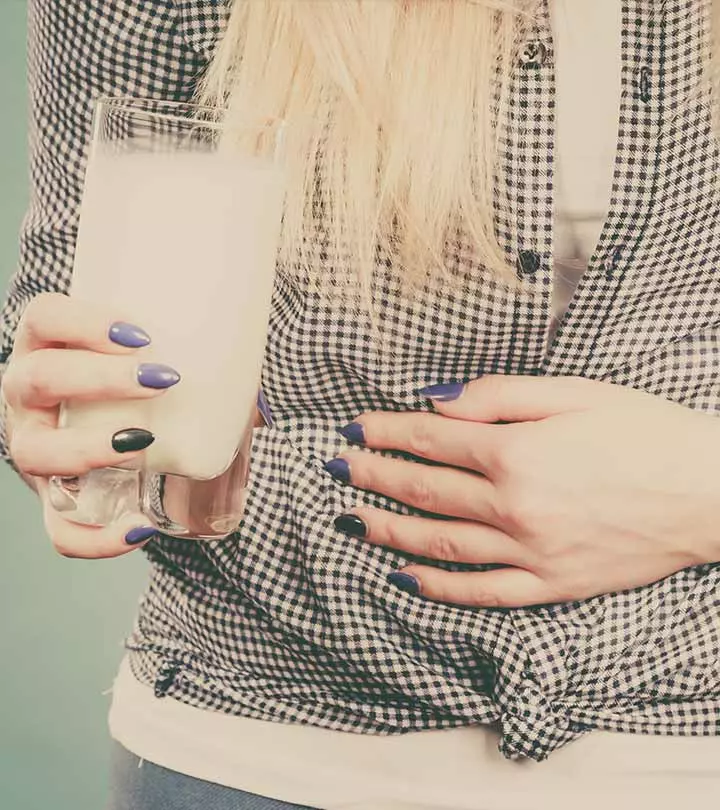

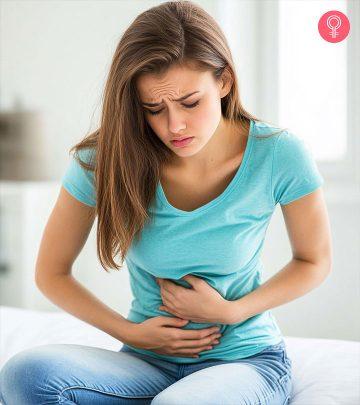

Community Experiences
Join the conversation and become a part of our empowering community! Share your stories, experiences, and insights to connect with other beauty, lifestyle, and health enthusiasts.